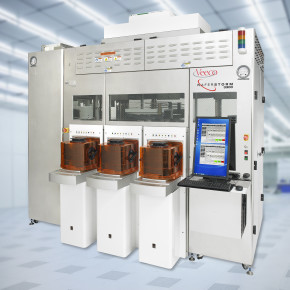Display Technology Innovator Expands Portfolio of Veeco Thin Film Process Technologies to Advance Next-Generation 3D Micro-LEDs
PLAINVIEW,
New York, — Veeco Instruments Inc. (Nasdaq: VECO) announced today that
Aledia, a developer and manufacturer of next-generation 3D LEDs for
display applications, has expanded its portfolio of Veeco thin film
process equipment to support the development and production of advanced
3D micro-LEDs. Aledia cited Veeco’s proven leadership in compound
semiconductor applications, GaN-on-silicon growth performance, and
capability to grow a full range of high-quality epitaxial films as key
factors influencing its decision.
Veeco’s Propel™ Power GaN MOCVD system is
designed specifically for the power electronics industry. Featuring a
single-wafer reactor platform, capable of processing six- and eight-inch
wafers, the system deposits high-quality GaN films for the production
of highly efficient power electronic devices.
“We
have been impressed with the performance of Veeco’s Propel™ GaN MOCVD
platform for large-wafer 3D LED production, and naturally turned to
Veeco again to support our advanced LED development,” said Philippe
Gilet, co-founder and CTO of Aledia. “Veeco’s solutions meet our
rigorous material quality and system delivery requirements along with
unmatched material flux stability and repeatability. We are excited to
take the next step with them in producing next-generation 3D
micro-LEDs.”
The collaboration between Aledia and
Veeco reflects the immense promise of micro-LEDs and other advanced LEDs
for the future of displays. Micro-LEDs offer high efficiency,
brightness and reliability benefits with shorter response time, enabling
lighter, thinner and flexible displays with energy saving advantages
for applications such as wearables, smartphones, automotive,
signage/large TVs, augmented reality/virtual reality, etc. According to a
recent Yole Développement report, there have been close to 1,500
patents filed related to micro-LED display from 125 different companies,
with the bulk of activity occurring after 2012.
“With
the significant shift toward exploration of micro-LEDs for use in
next-generation displays, leaders like Aledia are turning to Veeco,”
said Gerry Blumenstock, senior vice president and general manager of
Veeco’s compound semiconductor business unit. “Veeco’s proven materials
engineering expertise puts us in a unique position to offer innovative
thin film deposition technologies for customers tackling tough compound
semiconductor research, development and production challenges.”
Veeco
will exhibit and present at the CS International Conference, March
26-27, 2019 in Brussels, Belgium. Mark McKee, director of product
marketing for Veeco’s MOCVD business unit, will present “Accelerating
Photonics Growth through Advances in High Performance As/P MOCVD and Wet
Processing Technology,” on March 27, 2019 at 9:50 a.m. CET.












